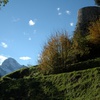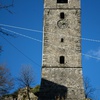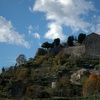Fort of Sassi
The village of Sassi was built on top of a hill close to a rocky overhang under which the Torrita Secca flows. Of the original fortification the signal tower and the west side of the fortress are still visible today, the result of reconstruction carried out by Lucca in the fourteenth century.
Inside the fortress there is the notable Church of San Frediano di Sassi with a unique nave, characterised by a solid apse wall that evokes the appearance of a fortified building. Of particular interest is the ceiling of the church, completed in 1788 in carved and painted wood.
Historical notes
The first testimonies regarding the village of Sassi are from the first half of the tenth century; subsequently the village is mentioned in a document from 952 together with other villages which have since disappeared. A Sassi "site" also appears in a decree drawn up by the Countess Matilde in 1105 on the occasion of her visit to the parish of Pieve Fosciana and, subsequently in 1168.
During the course of the thirteenth century, Sassi suffered the fate of many nearby castles, ending up under the rule of Lucca. On the death of Castruccio Castracani, when Florence and Pisa divided up Lucca and its land, Sassi was included in the Vicariate of Gallicano (Pisa). Later, Emperor Charles IV of Bohemia freed Lucca; Sassi returned under the dominion of Lucca until 1430, when it requested the protection of Niccolo d'Este, Marquis of Ferrara.
An important date in the history of the fortress of Sassi is 28 July 1524, when Ludovico Ariosto, Este Governor of the Garfagnana, paid a visit to assess the state of conservation of the fort, in an attempt to dissuade the Duke Ercole II from plans to abandon the property. The event is still commemorated today during the Mediaeval Festival which is held every year on July 28.











